初一英语下册教案
- 格式:docx
- 大小:21.23 KB
- 文档页数:14

初一仁爱版下册英语教案初一仁爱版下册英语教案1教材分析1.本节内容就是为了进一步巩固主句为一般过去时的宾语从句,是对上一节课的巩固,并为以后的学习做了铺垫。
这节课学的知识是本册书的重点之一。
学情分析1,通过练习发现学生宾语从句并不是很懂,做起题来很蹩脚。
2,由于宾语从句是新学的语法项目,学生在日常学习中也接触,但由于在语文中并不涉及,这为英语中宾语从句的学习设置了障碍。
所以学生学起来有一定的难度。
教学目标知识与能力目标:1,学习新单词和主句为一般过去时的宾语从句;2,继续谈论时装表演,了解各民族服装;3,通过本课学习,使学生对中国服装文化能有更深刻的了解。
过程与方法:让学生在反复练习的基础上,能够很自然的掌握宾语从句。
情感态度和价值观:通过対本课的学习,让学生了解民族服装文化,加强对民族服装文化的了解,增进民族感情。
教学重点和难点主句为一般过去时的宾语从句教学过程(本文来自优秀教育资源网斐.斐.课.件.园)Step 1. Review the object clauses of which the main clauses are in the past simple tense..Step 2. Lead in the new lesson and learn new words.Step 3.Presention:1.Listen to the tape and pay attention to the pronunciation. Read 1ain different ways to learn it2. Let the students answer some questi. And then fill in blanks according to 1a.Step 4. PracticeLead into Part 2and practice the object clauses of which the main clauses are in the past simple tense.Step 5.Colidation :Step 6.Homework:教学环节一,复习二,导入三,呈现四,练习五,巩固六,作业复习宾语从句,然后利用宾语从句引入新课,并展示图片,学习生词,进而学习少数民族服装,处理第三部分。
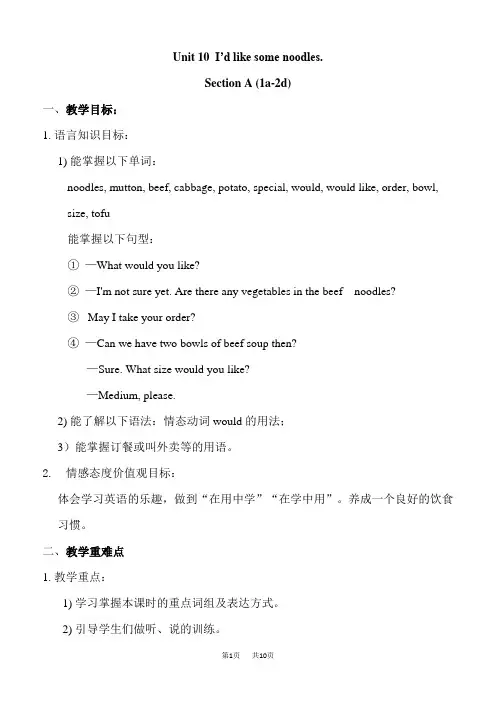
Unit 10 I’d like some noodles.Section A (1a-2d)一、教学目标:1. 语言知识目标:1) 能掌握以下单词:noodles, mutton, beef, cabbage, potato, special, would, would like, order, bowl, size, tofu能掌握以下句型:①—What would you like?②—I'm not sure yet. Are there any vegetables in the beef noodles?③ May I take your order?④—Can we have two bowls of beef soup then?—Sure. What size would you like?—Medium, please.2) 能了解以下语法:情态动词would的用法;3)能掌握订餐或叫外卖等的用语。
2. 情感态度价值观目标:体会学习英语的乐趣,做到“在用中学”“在学中用”。
养成一个良好的饮食习惯。
二、教学重难点1. 教学重点:1) 学习掌握本课时的重点词组及表达方式。
2) 引导学生们做听、说的训练。
2. 教学难点:通过role-play的方式掌握如何订餐等用语。
三、教学过程Ⅰ. Warming-up and lead in1. Watch a video program about food and vegetables.2. Ask and answer: What's your favorite food/drink/vegetables?Ⅱ. Presentation1. (show some pictures of food on the big screen)Present some new words and expressions to the Ss.2. Ss learn the new words and expressions by themselves and try to remember them.3. Work on 1a:Read the words on the left and look at the pictures on the right.the letters of the food on the . Then check the answers.Ⅲ. Game (Guess the food.)(Show some pictures of food on the big screen)Let Ss guess what food it is.Ss try to guess the food and learn the words.Ⅳ. ListeningT: In the following conversation, one man is ordering some food. Now, let’s listen to the tape, find out the right noodles the person orders.Play the recording for the Ss to listen and check the answers.Ⅴ. Pair work1.Present the conversation in 1b on the big screen and ask Ss to practice it.2. Make their own conversations using the noodles in the picture.3. Let some pairs act out their conversations.Ⅵ. Listening1. Work on 2a;T: Now, look at the pictures on the right, listen to the conversations and check the names of the foods you hear.(Play the recording for the first time, students listen carefully.Then, listen to the recording again, and check the names of the foods.Check the answers. )2. Work on 2b:(Play the recording for the Ss to listen and complete the sentences.)Play the recording twice. The first time Ss just listen. And the second time, Ss listen anddown the words.(If necessary, use the pause button to help Ss)3. Check the answers.Ⅶ. Pair work1. Ask and answer questions with your partner. Use the information in 2a.2. Show the conversations of 2a on the big screen to the Ss.3. Make a model for the Ss.T: What kind of noodles would you like?S1: I'd like beef noodles, please.…3. Ss work in pairs and practice the conversations.Ⅷ. Role-play1. Ask Ss to read the conversation in 2d and find the answer to the questions:What would they like?(They would like one large bowl of beef soup, one gongbao chicken, and one mapo tofu with rice.)2. Check the answers with the Ss.3. Ss work with their partners and role-play the conversation.VIII. Language pointsIX. ExercisesX . Homework1. Review the words and expressions in period.2. Role-play the conversation in 2d.3. Make a short conversation to order some noodles you like in a restaurant.Section A (Grammar Focus-3c)一、教学目标:1. 语言知识目标:1) 继续练习运用如何订餐或叫外卖等的用语。

Unit 1 Can you play the guitar?Section A (1a-2d)一、教学目标:1. 语言知识目标:1) 能掌握以下单词:guitar, sing, swim, dance, chess, play chess, draw, speak, speak English, join, club能掌握以下句型:①—Can you play the guitar? —Yes, I can./ No, I can't.②—What can you do? —I can dance.③—What club do you want to join? —I want to join the chess club.2) 能了解以下语法:情态动词can的用法want to do sth.的用法二、教学重难点1. 教学重点:1) 学习询问和谈论彼此的能力和特长;2) 掌握一些弹奏乐器的表达方式。
2. 教学难点:情态动词can的构成和使用。
三、教学过程Ⅰ. Lead in1. 教师可携带一些易于演奏的乐器,也可带一些演奏乐器的图片,一边演示乐器,一边说: Ican play the guitar.…等;再指着图片说:He/She can play the violin.But I can’t play it.等;然后询问学生:Can you play the guitar?….并引导学生进行简单的回答。
2. S s look at the picture in 1a. Then read the words and phrases. Let Ss match the activities with thepeople.Then Check the answers with the class together.Ⅱ. Presentation出示一些反映各种活动的图片、幻灯片或播放课件,引导学生谈论活动:He/She can dance/swim/sing/"··But I can’t dance/swim/sing/...等,学习表达活动的动词短语。
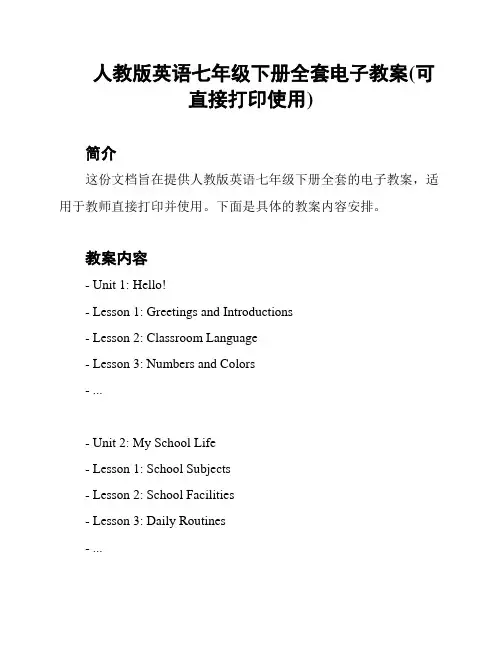
人教版英语七年级下册全套电子教案(可直接打印使用)简介这份文档旨在提供人教版英语七年级下册全套的电子教案,适用于教师直接打印并使用。
下面是具体的教案内容安排。
教案内容- Unit 1: Hello!- Lesson 1: Greetings and Introductions- Lesson 2: Classroom Language- Lesson 3: Numbers and Colors- ...- Unit 2: My School Life- Lesson 1: School Subjects- Lesson 2: School Facilities- Lesson 3: Daily Routines- ...- Unit 3: My Family- Lesson 1: Family Members- Lesson 2: Describing Family Members - Lesson 3: Daily Life- ...- Unit 4: My Friends- Lesson 1: Making Friends- Lesson 2: Describing People- Lesson 3: Talking about Hobbies- ...- Unit 5: My Day- Lesson 1: Daily Activities- Lesson 2: Time and Schedules- Lesson 3: Talking about the Weekend - ...- Unit 6: My Free Time- Lesson 1: Leisure Activities- Lesson 2: Likes and Dislikes- Lesson 3: Planning for the Future - ...- Unit 7: Summer Vacation- Lesson 1: Vacation Plans- Lesson 2: Talking about Places- Lesson 3: Past Experiences- ...- Unit 8: Festivals and Celebrations - Lesson 1: Chinese Festivals- Lesson 2: Western Festivals- Lesson 3: Celebrating with Friends - ...- Unit 9: At the Farm- Lesson 1: Farm Animals- Lesson 2: Talking about Farm Work - Lesson 3: Farm Produce- ...- Unit 10: Environmental Protection- Lesson 1: Environmental Problems- Lesson 2: Actions for the Environment- Lesson 3: Protecting Our Earth- ...使用说明- 教案可根据需要直接打印使用。
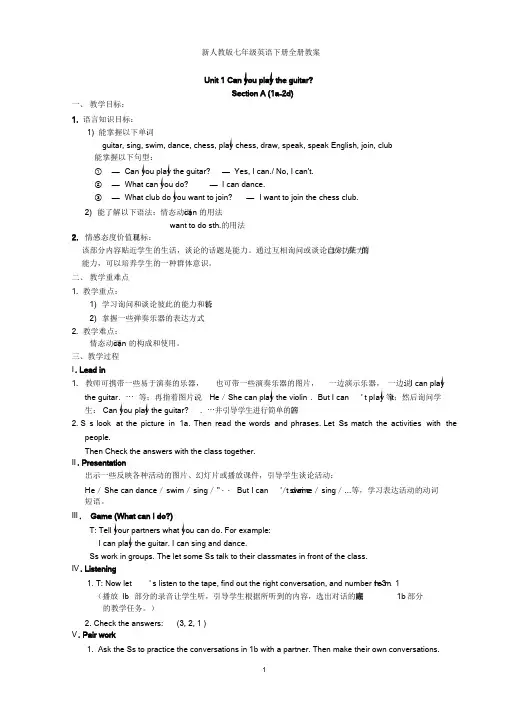
新人教版七年级英语下册全册教案Unit 1 Can you play the guitar?Section A (1a-2d)一、教学目标:1. 语言知识目标:1) 能掌握以下单词:guitar, sing, swim, dance, chess, play chess, draw, speak, speak English, join, club 能掌握以下句型:①—Can you play the guitar? —Yes, I can./ No, I can't.②—What can you do? —I can dance.③—What club do you want to join? —I want to join the chess club.2) 能了解以下语法:情态动词c an 的用法want to do sth.的用法2.情感态度价值观目标:的某一方面己或对方在该部分内容贴近学生的生活,谈论的话题是能力。
通过互相询问或谈论自能力,可以培养学生的一种群体意识。
二、教学重难点1. 教学重点:1) 学习询问和谈论彼此的能力和特长;2) 掌握一些弹奏乐器的表达方式。
2. 教学难点:c an 的构成和使用。
情态动词三、教学过程Ⅰ. Lead in1. 教师可携带一些易于演奏的乐器,也可带一些演奏乐器的图片,一边演示乐器,一边说:I can playthe guitar.⋯等;再指着图片说:He/She can play the violin .But I can ’t pl.a y等it;然后询问学。
生:Can you play the guitar? .⋯并引导学生进行简单的回答2. S s look at the picture in 1a. Then read the words and phrases. Let Ss match the activities with thepeople.Then Check the answers with the class together.Ⅱ. Presentation出示一些反映各种活动的图片、幻灯片或播放课件,引导学生谈论活动:He/She can dance/swim/sing/" ··But I can ’/t s d w a n i m c e/sing/...等,学习表达活动的动词短语。
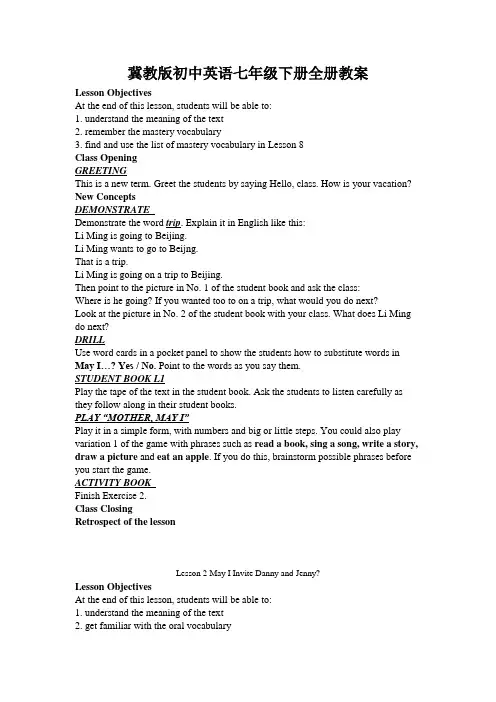
冀教版初中英语七年级下册全册教案Lesson ObjectivesAt the end of this lesson, students will be able to:1. understand the meaning of the text2. remember the mastery vocabulary3. find and use the list of mastery vocabulary in Lesson 8Class OpeningGREETINGThis is a new term. Greet the students by saying Hello, class. How is your vacation? New ConceptsDEMONSTRATEDemonstrate the word trip. Explain it in English like this:Li Ming is going to Beijing.Li Ming wants to go to Beijng.That is a trip.Li Ming is going on a trip to Beijing.Then point to the picture in No. 1 of the student book and ask the class:Where is he going? If you wanted too to on a trip, what would you do next?Look at the picture in No. 2 of the student book with your class. What does Li Ming do next?DRILLUse word cards in a pocket panel to show the students how to substitute words in May I…? Yes / No. Point to the words as you say them.STUDENT BOOK L1Play the tape of the text in the student book. Ask the students to listen carefully as they follow along in their student books.PLAY “MOTHER, MAY I”Play it in a simple form, with numbers and big or little steps. You could also play variation 1 of the game with phrases such as read a book, sing a song, write a story, draw a picture and eat an apple. If you do this, brainstorm possible phrases before you start the game.ACTIVITY BOOKFinish Exercise 2.Class ClosingRetrospect of the lessonLesson 2 May I Invite Danny and Jenny?Lesson ObjectivesAt the end of this lesson, students will be able to:1. understand the meaning of the text2. get familiar with the oral vocabularyClass OpeningGREETINGRemember to greet the students with phrases they have learned.PLAY “MOTHER, MAY I?”This is a good game to review May I…? Yes/ No, you may / may not.New ConceptsDEMONSTRATERole-play come and go with students in the class. Use gestures to make your meaning clear. For example, ask individual students to come and then go.Lead the class through a dialogue such as this:Teacher: I want to go on a trip to Beijing! (Pick up your suitcase, point ahead and start walking.) Here I go! (Stop and point to a student.) You come, too. You come with me. (Start walking again, with the student.) Let’s go.PRACTICEPlay “The Trip Game.” Refer to the “Games” section at the back of this guide. DEMONSTRATENote that this lesson uses leave and arrive. The students know most of the words in the sentences that use leave and arrive. Can they guess what the words mean? Remember to praise any student who tries to answer.STUDENT BOOK L2Play the tape of the text in the student book. They follow the text in their book and pay special attention to come on our trip and go on a trip.ACTIVITY BOOKFinish Exercise 2.PRACTICEDiscuss the story in the student book. What does Li Ming want? (He want s Danny and Jenny to come.)How does Mrs. Li talk to Mrs. Smith? (On the telephone.) where is Mrs. Smith? (In Canada.) Can Jenny come on the trip? Can Danny come?Class ClosingRetrospect of the lessonLesson 3 How Far Is Beijing?Lesson ObjectivesAt the end of this lesson, students will be able to:1. understand the meaning of the text2. remember the mastery vocabulary3. find and use the list of mastery vocabulary in Lesson 8Class OpeningGREETINGPLAY “THE TRIP GAME”Play variation 2 of the game.New ConceptsDEMONSTRATENumbers are very regular in English. Once you know how to count to 100, you can count to 1000. Teach them how to read the numbers between 100 and 1000.E.g. 101: one hundred and one426: four hundred and twenty-six917: nine hundred and seventeenDemonstrate about with examples. Draw two quick stick people on the blackboard, a very tall boy and very short girl. Draw a tape measure beside each with an exact height marker off(such as 1.8 metres and 1.2 metres ) Lead a dialogue such as: Teacher: (Point to ech stick person in turn.) He is one-point-eight metres tall. How tall is she?Class: One point two metres tall.Teacher: Yes, he is one point eight etres tall and she is one point two metres tall. He is about two metres tall and she is about one metre tall.PRACTICECall out any number and ask the students in any row to count sequentially from that number. Stop and start the game several times with different numbers and different rows of students.DEMONSTRATE1. Explain from…to…. Write the names of cities in China on the blackboard. Write the distances from our city to these cities on the blackboard. Work these out before class and use exact numbers. Then lead the dialogue like this:—How far is…? Or How far is it from…to …? It’s about…—About …kilometers.2. Teach near and far. Lead a dialogue like this:—(Standing next to the volunteer.) He / She is near. (Take the volunteer to a far corner of the room and walk back to my original position. Point to the volunteer.) Is he / she near or far?—Far.ACTIVITY BOOKFinish Exercise 3.Class ClosingRetrospect of the lessonLesson 4 How Can We Go to Beijing?Lesson ObjectivesAt the end of this lesson, students will be able to:1. understand the meaning of the text2. remember the mastery vocabulary3. understand and sing the song “A plane is fast. A bus is slow.”Class OpeningGREETINGPLAY “SPELL IT”Play “Spell it” to revew modes of transportation the students have mastered (bicycle, car, cab, truck). See the directions for this game in “Games” at the back of this guide. Leave the words on the blackboard. Then ask for volunteers to draw pictures to match the words.New ConceptsDEMONSTRATETeach: airplane, train, fast, faster, slow, slowerDemonstrate fast and slow by talking fast and slowly, or walking fast and slowly, asyou make up appropriate sentences.Demonstrate faster than and slower than with two balls of the same size, but different colours.Roll them at different speeds. Construct a sentence that describes their relative speed. As for volunteers to roll the balls and each construct a correct sentence that describes the relative speed of their ball.Demonstrate train and airplane with your large vocabulary cards. Then lead a dialogue such as:—(Hold up a vocabulary card.)What’s this?— A train/ An airplane.—Is a train faster than an airplane? (Use gestures to make your meaning clear.)—No…—No! A train is slower than an airplane. Is an airplane faster than a train?—Yes.—Yes, an a irplane is…—…faster than a train.Note that plane is short of airplane.STUDENT BOOK L4Review the story so far. Li Ming wants to go on a trip to Beijing. His mother is coming. Jenny and Danny are coming, too. Look at the pictures in No. 1 of the student book. What’s it about?DEMONSTRATELet’s take…Show the meaning of take first by doing some actions and at the same time holdingyour word cards of transportation vehicles. And then ask your students to join in your actions, and say: Let’s take a bic ycle or Let’s take a bus.STUDENT BOOK L4Teach “The Trip Song” in No. 3 of the student book with the tape.Then sing the song.ACTIVITY BOOKFinish Exercise 2.Class ClosingRetrospect of the lessonLesson 5 Leaving and ArrivingLesson ObjectivesAt the end of this lesson, students will be able to:1. understand the meaning of the text2. remember the mastery vocabulary3. understand and learn “The leave arrive chant”Class OpeningGREETINGPLAY “WHAT DAY IS IT?” AND SING “THE TRIP SONG”New ConceptsDEMONSTRATEarrive, leaveDraw a circle at each end of the blackboard. Label one circle with the name of your home city. Label the other with the name of another city. Ask for a volunteer. You and the volunteer stand next to your home city. Lead the dialogue such as this:—Please go to…(the other circle)—(start walking to the other circle.)—Goodbye. He/ She is leaving… Please come to…(the first circle.) Now, he/she is arriving inSTUDENT BOOK L 5Play the tape.PRACTICEDivide the class into small groups: Ask each group to plan a trip to Beijing the way Li Ming planned a trip in the student book.DEMONSTRATEStudy the course plan of your students. Find out what classes they have on Monday, Tuesday, Wednesday, Thursday, Friday, Saturday and Sunday.CHANTTe ach “The leave arrive Chant”ACTIVITY BOOKFinish Exercise 2.Class ClosingRetrospect of the lessonLesson 6 Li Ming Packs His SuitcaseLesson ObjectivesAt the end of this lesson, students will be able to:1. understand the meaning of the text2. remember the mastery vocabulary3. understand and chant “The This That”Class OpeningGREETINGREVIEW “NEAR”AND”FAR”Review near and far. Ask two volunteers to stand on close to you and one in a far corner of the room. Lead a dialogue such as:—(Indicate the volunteer close to you.)…is near. (Point to the other volunteers and talk to first volunteer.) Is…near or far?—…is far.(Repeat with other volunteers and eventually allow students to lead the dialogue.)DRILLReview regular plurals with an object-prompt drill..You show a book, and say “I have a book.” Then you add another book and say, “Now I have two books.” and so on.New ConceptsDEMONSTRATEThis, that, these, thoseUse objects around the room and model the following structures:Teacher: (Hold up one object.) The …is near. This is near. (Point to an object far away) The…is far. That is far. (Hold up two objects.) The…s are near. These are near. (Point to two objects far away.) The …s are far. Those are far.Remind the students about some special plurals in English. Brainstorm a chart like this on the blackboard.This, that ——these, those;sweater——sweaters;pencil——pencils; pant——pants DRILLUse word cards in a pocket panel to show the students how to substitute words in the phrase I like this/that/these/those…(colour or other adjective)them. DEMONSTRATEPacking my / your / his / her suitcaseDo this with a real suitcase and real clothes. Use demonstrative pronouns to make choices anbout the clothes you pack.STUDENT BOOK L6Review the story so far. Jenny, Danny and Li Ming are going on a trip to Beijing. Look at the pictures in the student book with the class. What is Li Ming doing in this lesson? What is Jenny doing?Jenny and Li Ming use the words a pair of. The students have heard these words before. Does anyone remember what they mean?Play the tape.PRACTICE IN PAIRSDivide the class into pairs. Ask each pair of students to make up a dialogue about packing a suitcase. One student packs and one student helps. They can use their flashcards for clothes to prompt conversation about clothing choices, or they can draw and cut out clothes on paper. They can use a pencil case as a pretend suitcase for packing the clothes.Yes, please / No, thanks.Do you like this/ that/ these/ those…?A pair ofHow many…do yo u have?DEMONSTRATEClothes, jacketTeach jacket with the real clothes.CHANTTeach “The This Tat Chant” in No. 2 of the student ook.ACTIVITY BOOKFinish Exercise 1.Class ClosingRetrospect of the lessonLesson 7 Buying Train TicketLesson ObjectivesAt the end of this lesson, students will be able to:1. understand the meaning of the text2. remember the mastery vocabulary3. find and use the list of mastery vocabulary in Lesson 8Class OpeningGREETINGCHANT “THE LEAVE ARRIVE CHANT”TELL THE TIMEReview how to read time. Draw clocks on the blackboard and ask the class to recite the time.New ConceptsDEMONSTRATEJump / run / walk from…to… Sit down. Stand up.Act out jump, run and walk. Then do these actions from one object to another. Ask for a volunteer to do the actions from one object to another with you . Then ask for volunteers to do them without you. But as you direct, sometimes change your directions while your volunteers are still moving between objects.PLAY “TIC-TAC-TOE”Play “Tic-Tac-To e” Give the students directions such as those below. Note that, in English, you can say from…to… or to…from… Both are correct. The students must listen carefully to the construction of each sentence you say.Please walk to the clock from the door.Please d on’t run from the chair to the window.Please jump.PRACTICEPlay “Mother, May I?” with sit, stand and other vocabulary from this unit. ACTIVITY BOOKFinish Exercise 2.Class ClosingRetrospect of the lessonLesson 9 Getting on the TrainTeaching content:mastery words: get, get on, very, stop, stand, where, see, mana dialogue about getting on the train the usage of word look and seeTeaching goals:understand the meaning of the textlearn some mastery wordsTeaching key points: difference of see and lookThe usage of imperative SentenceDifficult points: the usage of Imperative SentenceTeaching aids: recorder, slide projector, flashcardsType : textTeaching procedureClass openingGreet the students in English and make sure they can response correctly.duty report (such as the weather, the school life, their classmates and teachers and so on)check yesterday’s homeworkNew lessonStep1 Lead inDiscuss the questions in “THINK ABOUT IT”Do you argue with your friends? Why?Do you have a friend who gets very excited? Who? Why?Answer the questions and say “We are going to learn a dialogue today. Li Ming and his friends are looking for their seats on the train. Danny sits on a wrong seat. So there is an argument. Now let’s look at it.Step2 Listen to the text with the following questions:Why is Jenny angry with Danny?Which is Danny’s seat?Step3 After listening to the tape, answer the questions and read through the whole text. Make sure they understand the meaning. Deal with the language points at the same time. ( using the slide projector)Step4 Listen to the tape again and let the students read after it.Step5 PracticeHave them read the dialogue aloud and correct their pronunciation if necessary. Then have them act it out in roles.Step6 Come to “LET’S DO IT”: Draw a map of the inside of a train. Draw the seats and write their numbers. You should also draw the door, washroom, stairs and hot water room on the map. Describe your map to a partner. Where do you like to sit? Why?Do this part in class if time permits.Step7 A test1. I see him ____ away.A. to runB. runC. runsD. ran2. I _____ but ____ nothing.A. looked, lookedB. looked , sawC. saw, lookedD. saw, saw3. The ____ behind the tree is Mary’s father.A. manB. womanC. boyD. girlStep8 SummaryToday we learn a dialogue about getting on the train. Hl Ming and his friends get on the train. They are very excited. Danny sits on the wrong seat. He takes another man’s seat. He has an argument with Jenny. In this text we learn some words such as look and see. We should be able to use them. You must practice after class.3. Homework1) Understand the meaning of the text2) Learn to use the mastery words3) Finish the exercise in the activity book4) Read the next reading in lesson 10Lesson 10 What Are They Looking at?Teaching content:Mastery words: find, their, woman, pointa dialogue about what they see through the train windowThere is/are…Teaching goals: At the end of this lesson, students will be able to:understand the meaning of the textremember the mastery wordsfind and use the list of mastery vocabulary in lesson 16Teaching key points: 1. There is/are….2. Difference of some words: see, look, watch, findDifficult points: the usage of some wordsTeaching aids: tape recorder, slide projector, word cardsType: dialogueTeaching procedureClass openinggreetings in Englishduty report (say anything he/she likes to say)check the homework of last lessonNew lessonStep 1 Lead inDiscuss the questions in “THINK ABOUT IT” with the students:Look out of the window of your classroom. What can you see?What can you see out of your bedroom window?In this part they will have many things to say. Their answers may be different. Gather their answers.Step 2 Play the audiotape with the following questions:What do Danny and Jenny see outside?Can they see a village?Is there a school outside the train?Answer the questions and discuss the whole text with the students. Make sure they understand the meaning of the text. Deal with the language points at the same time. The teacher can write the important points on the blackboard or use the slide projector.Step 3 Listen to the audiotape again and let them read after it.Step 4 Have them read the text aloud for a few minutes and then let them act out the text in roles. Step 5 PracticeDivide the class into small groups. Ask them to make up a dialogue that uses loud and quiet. Please read about making up dialogues in “Teaching Techniques.” To make up a dialogue, the students need to think and be creative! Encourage them to use the dialogue in the student book asan example, not as something to memorize.Step 6 Deal with “LET’S DO IT”Work with two partners. Write and practice a dialogue. What else do you think Jenny, Danny and Li Ming see? Present your dialogue to your classmates.Step 7 A test词形转换1)quiet (反义词)__________ 2) read (现在分词) _______3) bottle (复数) _____________ 4) drawing (原形) __________5) sing (现在分词) ___________ 6) tree (复数) _________7) photo (近义词) ___________ 8) woman (复数)________9) baby (复数) _____________ 10) be (第三人称单数) ________Step 8 Activity bookIf time permits, do exercise 1Homeworkunderstand the meaning of the text in lesson 10finish the exercises in activity booknext reading in student bookLesson 11 Danny’s New FriendsTeaching content:mastery words: farm, hear, meet, course, of course, lot, lot of, enjoy2. A dialogue between Danny and his new friend3. The usage of some phrasesTeaching goals: At the end of the lesson, the students will be able to:1. Understand the meaning of the text2. Remember the mastery words3. Find and use the list of mastery vocabulary in lesson 16Teaching key points: 1.introduce where you are from2. some useful expressionsDifficult points: how to introduce yourselfTeaching aids: word cards, audiotape, flashcards, and slide projectorType: dialogueTeaching procedureClass openingGreet the students in everyday English.Duty report.Main revision of last lesson. Explain when necessary.New lessonStep1 Lead inAsk the students some questions:Do you like to make new friends? Why or why not?Who is your newest friend? How do you meet?Discuss them with the class and you gather many different answers.Step2 Listen to the tape and answer the following questions:What does Danny want to buy in Beijing?Who is Danny’s new friend?Where does Wu Li come from?After listening to the tape, answer the questions and discuss the whole text. Make sure the students understand the meaning of the text. Deal with the language points in this period. Write the key points on the blackboard or use the slide projector.Step3 Listen to the audiotape again and let the students read after it.Step4 PracticeHave them read the text aloud for a few minutes and correct their pronunciation when necessary. Then have them act out the dialogue in roles.Step5 Deal with “LET’S DO IT”You meet a new friend on the train or bus. What should one say to a new friend? What can one do to enjoy time with a new friend? With a partner, write and practice a dialogue. Present your dialogue to your classmates.In this part the teacher should guide the students to discuss the questions.You may give them some words to help them.Step6 A test句型转换1)The woman behind me is singing. (一样疑问句)______________________________________?2) She is talking to the man. (对划线部分提问)___________________________________?3) The baby is sleeping. (否定句)____________________________.Walk to the station. (否定句)_________________________.Ben is noisy in class. ( 同义句)___________________________.Step7 SummaryToday we learn a dialogue about Li Ming and his friends. They meet a new friend on the train. Then they feel hungry and they discuss what to eat. What did they say? After class, read the text fluently.Homeworkunderstand the meaning of the textfinish the exercises in the activity bookread the dialogue in the next lesson.Lesson 12 Lunch on the TrainTeaching content:mastery words: wait, drink, fruit, grape, thirsty, bottle2. a dialogue about having lunch on the train3. What would you like?I would like …..4. Plural Forms of NounsTeaching goals: At the end of this lesson, the students will be able to:1. Understand the meaning of the text2. Remember the mastery words in this lesson3. find and use the list mastery vocabulary in lesson 16Key points: 1. express your favourite2. Some useful expressions3. Plural Forms of NounsDifficult points: how to express your favouriteHow to express some liquid thingsTeaching aids: word cards of different food, flash cards, audiotape, and slide projectorType: textTeaching procedure1. Warming upGreetings in everyday English.Duty report (about weather, your classmates, your teacher and so on)Mainly revision of last lesson2. New lessonStep1 Lead inDiscuss the questions in “THINK ABOUT IT”Do you like to eat lunch on the train or bus?What do you like to eat when you travel?Let the students learn to express themselves freely.We are going to learn a text today. Let’s look at what Li Ming and his friends want to eat on the train?Step2 Listen to the tape with the following questions.What do Danny, Jenny and Li Ming want to eat?What did Wu Li buy on the train?What is a snack?Answer the questions with the students and discuss the whole text to make sure they understand the meaning of the text. Deal with the language points at the same time. The teacher can use blackboard or the slid projector to help the teaching.Step 3. Listen to the audiotape again and let the students read after it and pay attention to the pronunciation.Step 4. Have them read the text for a few minutes and then ask them to act out the dialogue in roles.Step 5. Practice: LET’S DO ITIn a small group, make a menu for the train. What foods can you buy on the train? How much do they cost? Write the menu on a piece of paper. Practice using the menu with your classmates. Divide the class into pairs. Each pair makes up a dialogue about being thirsty and wanting something to drink. The students can use their flashcards to represent drinks.Step 6 A test词汇1)一杯茶_______ 2) 一杯水______ 3) 一箱子鸡蛋________4) 一瓶汽水________ 5) 五瓶热水_______ 6) 十位女教师_______7) 九位男大夫_______ 8) 三张票_________ 9) 两个儿童________Step 7 ExerciseIf time permits, do Number 2 in activity book.3. Homework1) understand the meaning of the text of lesson 122) finish the activity book in lesson 123) the next readingLesson 13 What Are You Doing?Teaching content:1.Mastery words: quiet, word, newspaper, baby2.A dialogue about what they are doing3.Present Continuous TenseTeaching goals:1. understand the meaning of the text2. remember the mastery words3. use the Present Continuous TenseKey points: 1. What are you doing?I am……2. some useful wordsDifficult points: the Present Continuous TenseTeaching aids: audiotape, flashcards, slide projector, word cardsType: textTeaching procedureClass openingGreet the students in everyday English and make sure they can response correctly.Duty report: they can say anything they like to sayCheck the homework in lesson 12 and explain when necessary.New lessonStep 1 Lead inDiscuss the questions in “THINK ABOUT IT”What is your favourite game? Why?Do you like babies? Why or why not?Today we are going to learn a dialogue. It happens on the train. Li Ming and his friends are doing different things. Let’s look at what they are doing.Step 2 Listen to audiotape and answer the following questions:What is the baby doing?What are Wu Li and Jenny doing?What is Danny doing?Answer them with the students and discuss the text again. Deal with some important points at the same time. Make sure the students understand the meaning of the dialogue. When explaining thelanguage points the teacher can use some pictures, write on the blackboard or on the slide projector.Step 3 Listen to audiotape again and let the students read after it.Step 4 Have them read the text aloud and correct their pronunciations when necessary. Then have them act out the dialogue in roles.Step 5 PracticeDivide the class into small groups. Ask each group to make up a dialogue about offering and eating foods. When the students “eat,” some are quick and some are slow. The students need to be creative about situations where this would happen!Step 6 Deal with “LET’S DO IT”Play a word game in a small group. Cut some pieces of paper into 2cm squares. Try to make about 100 squares. On each piece of paper, write a letter of the alphabet. Then use the squares to make English words. Join the words together like a crossword.Step 7 A test依照首字母完成句子Welcome to Beijing! You want to know something about Chinese f____. Let me tell you. We eat r____, v_____, f______ and m_____ every day. We also have d_______ or n_______ .You can find your f________ food. At 12:00 we eat l_______ . (food, rice, vegetables, fruit, meat, dumplings, noodles, favourite)Step 8 SummaryToday we learn a dialogue between Li Ming and his friends. They are on the train to Beijing. They are doing different things. Jenny and Wu Li are playing a word game. Danny is playing with a baby. So we must remember how to express what sb. is doing. After class you should practice the Present Continuous Tense.Homeworkunderstand the meaning of the textremember the mastery words in this lessonfinish the activity book of lesson 13Lesson 14 What Is He Selling?Teaching content:mastery words: sleep, loudly, listen, tiredWhat is he/she doing?He /She is …..some useful word: tired, loudTeaching goals:understand the meaning of the textremember the mastery wordsuse the Present Continuous TenseKey points: 1. the usage of tired, sleep, listen and loudWhat is he/she doing?Difficult points: the usage of the Present Continuous TenseTeaching aids: pictures or some real objects, audiotape, flash cards, slide projectorType: textTeaching procedureClass openinggreetings in everyday Englishduty reportmainly revision of last lessonNew lessonStep 1 Lead inDiscuss some questions in “THINK ABOUT IT”Is it expensive to buy things on the train ? Why or why not?Do you like to buy things from salesman on the train? Why or why not?Answer them together with the students.Step 2 Listen to the tape of the text with the following questions:Why is the baby crying? What is the mother doing?What is Danny doing?Does Wu Li buy some socks on the train?Answer the questions and discuss the whole text to make sure the students understand the meaning of the text. Deal with the language points at the same time.Step 3 Listen to the audiotape again and let the students read after it.Step 4 Have them read the text for a few minutes and correct their pronunciation if necessary. Then let them act out the dialogue in roles.Step 5 PracticeDivide the class into small groups. Ask each group to make up a dialogue about doing something and then doing something else. Ask each group to use the word now and any other vocabulary they like. Encourage your students to experiment and be creative! English is fun and easy! Please read about making up dialogue in “Teaching Techniques.”Step 6 Discuss “LET’S DO IT”Work in a small group. Write a role play and practice it. One of you is a salesman. The other are customers. What is the salesman selling? Present your role play to your classmates.Step 7 A test句型转换1)Look!They are eating dumplings. (对划线部分提问)___________________________________2)She is playing with the toy. (对划线部分提问)______________________________________3) He is talking to his aunt. (对划线部分提问)______________________________1. We would like to eat oranges. (对划线部分提问)Step 8 ExerciseDo activity book lesson 14 Number 2. The students listen to four sentences and draw four pictures correspondingly. The audiotape goes like:Listen and draw the pictures.The woman is crying.The man is laughing.。

七年级英语下册全英文教案(全册全英文)Unit 1 Can you play the guitar?Step 1 LeadingT:What do they do in the picture?S:They...(见课件)T:Can you/he sing/ swim/ dance...?S:I/He can...T:There are many clubs.What club do you want to join?(见课件)S:I want to join the music club.Because I can sing....Step 2 Listening1.Ask the students to read the conversations in 1b first.2.Ask the students to listen and number the conversations [1-3] in 1b.3.Check the answers.(见课件)4.Ask the students to read the club names in 2a.5.As k the students to listen to two conversations and circle the clubs they hear.6.Ask one student to show the answers.(见课件)7.Listen again and complete the sentences in 2b.8.Ask three students to show their answers.(见课件)Step 3 Make similar conversations1.Look at 2b and talk ab out what the people can do and the clubs they want to join.2.Show an example.(见课件)Step 4 Role-play1.Ask the students to read the conversation in 2d,try to find:What can Jane/ Bob do?What club do they want to join?2.Ask the students to fill in the form.(见课件)What can...do? What club does...want to join? BobJane3.Ask students to practice the conversation according to the for m.4.Ask students to perform the conversation.Step 5 Explain several important words and phrases.(见课件)Step 6 HomeworkMake a survey about what your friends can do and what club your friends want to join. 板书设计Section A(1a-2d)重点单词短语重点句型1.play the guitar/play basketball2.want to do sth.3.join/join in/take part i n4.be good atUnit 1 Can you play the guitarImportant phrases:talk to,kung fuImportant sentences:1.—Can yo u/he/they swim?—Yes,I/he/they can./—No,I/he/they can’t.2.—What can you do?—I can dance./ I can’t sing.3.—What club do you want to join?—We want to join the chess club.【能力目标】能熟练运用所学目标语言谈论自己所长。
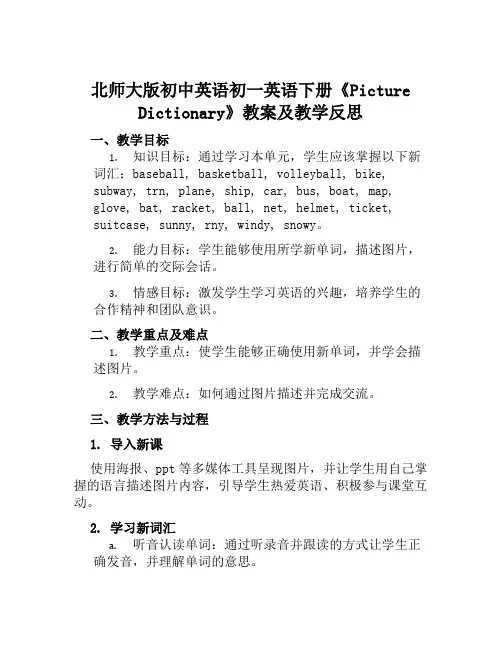
北师大版初中英语初一英语下册《Picture Dictionary》教案及教学反思一、教学目标1.知识目标:通过学习本单元,学生应该掌握以下新词汇:baseball, basketball, volleyball, bike,subway, trn, plane, ship, car, bus, boat, map,glove, bat, racket, ball, net, helmet, ticket,suitcase, sunny, rny, windy, snowy。
2.能力目标:学生能够使用所学新单词,描述图片,进行简单的交际会话。
3.情感目标:激发学生学习英语的兴趣,培养学生的合作精神和团队意识。
二、教学重点及难点1.教学重点:使学生能够正确使用新单词,并学会描述图片。
2.教学难点:如何通过图片描述并完成交流。
三、教学方法与过程1. 导入新课使用海报、ppt等多媒体工具呈现图片,并让学生用自己掌握的语言描述图片内容,引导学生热爱英语、积极参与课堂互动。
2. 学习新词汇a.听音认读单词:通过听录音并跟读的方式让学生正确发音,并理解单词的意思。
b.记忆单词:通过图片配单词的方式帮助学生记忆单词。
c.练习发音和拼写:进行集体或小组合作游戏,调动学生的积极性,帮助学生在愉悦的氛围下快速掌握新单词。
3. 运用新词汇a.个人练习:让学生就所学单词描述一张图片,并与同桌分享。
b.小组合作:小组合作,交流分析自己和他人的图片描述,推敲单词的用法和语法。
c.文章撰写:学生分组撰写一篇关于自己喜欢的运动的短文,要求使用所学单词,并在文中进行图片描述。
4. 总结本堂课对本节课所学内容进行总结,巩固并检查学生掌握情况。
四、教学反思此次教学中,通过使用多媒体工具呈现图片,让学生用自己掌握的语言描述图片内容,成功地调动了学生的积极性和参与度,也真正让学生体验到用英语交流的乐趣,达到了情感目标。
同时,在教学中也遇到了不少问题。

七年级英语下册《Unit Donteatinclass》教案人教版第一章:教学目标与内容1.1 教学目标能够听懂、会说、会读本课的生词和短语。
能够正确使用所学的日常交际用语进行简单的交流。
能够理解并在适当的情境中运用本课的主要句型。
1.2 教学内容生词和短语的学习。
日常交际用语的练习。
主要句型的运用。
第二章:教学过程与方法2.1 教学过程热身活动:通过简单的英语歌曲或游戏,调动学生的学习积极性。
新课导入:介绍本课的主题和目标,引导学生进入学习状态。
新课教学:通过图片、视频等辅助材料,生动形象地展示本课的生词、短语和句型。
练习与实践:通过小组活动、角色扮演等形式,让学生充分练习和运用所学的知识。
2.2 教学方法交际法:通过模拟真实情境,让学生在实际交流中学习英语。
任务型教学法:通过完成各种任务,提高学生的综合语言运用能力。
情境教学法:通过创设各种情境,激发学生的学习兴趣和积极性。
第三章:教学资源与材料3.1 教学资源PPT课件:包含本课的生词、短语、句型和相关语法点。
教材:人教版七年级英语下册教材。
录音机或音响设备:用于播放英语录音或音乐。
3.2 教学材料生词卡片:用于帮助学生记忆和复习生词。
图片和视频:用于辅助教学,增加学生的学习兴趣。
第四章:教学评价与反馈4.1 教学评价课堂参与度:观察学生在课堂上的积极参与情况和表现。
口语表达:评估学生在角色扮演等实践活动中的口语表达能力。
作业完成情况:检查学生课后作业的完成质量和速度。
4.2 教学反馈及时给予学生积极的评价和鼓励,提高他们的学习自信心。
对学生的错误进行纠正,并指导他们正确的表达方式。
定期与学生进行沟通,了解他们的学习需求和困难,给予针对性的帮助和支持。
第五章:教学计划与时间安排5.1 教学计划第1周:学习生词和短语,掌握日常交际用语。
第2周:学习主要句型,进行口语练习。
第3周:进行小组活动,运用所学知识进行实际交流。
5.2 时间安排每节课时长为40分钟,每周4节课。

七年级英语下册教案篇一:2022人教版七年级下册全册英语教案英语七年级(下)教案一、【教学目标】(一)语言知识1.词汇掌握wake,early, first,day, term,must,still,by,onfoot,the same to,usually,always,Ms.,boat,ship,sea,train,by plane/air/airplane, etc.2.理解Subway Worm reporter,Net Bar,roller skating Measuredining hall,dormitory bookstore,etc. (二)语法1.一般现在时(Simple present)2.频度副词(Adverbs of frequency)never, seldom, sometimes,often, usually, always, once, twice3.现在进行时(Present continuous) a. I’m looking for a book.b. Are you doing your homework? Yes, I am./No, I’m not.c. Is he/she...?Yes, he/she is. /No, he/she isn’t.d. What are you doing now? I’m playing computer games.e. What is he/she doing? He/She is...4.谈论交通方式(Talking about means of transportation) How do you usually go to school? I usually go to school by bike. (三)功能用语与话题1.采访(Interviews)Our guest today is Michael from Class 2, Grade 1.2.谈论日常生活(Talking about routines)3.学校建筑(School buildings)swimming pool, playground,library, dormitory, lab, gym4.谈论兴趣喜好(Talking about interests, likes and dislikes)I like the swimming pool best. Why do you like English? Because it’s interesting and easy. 5.借物(Borrowing things)How long can I keep it? Two weeks. 6.新闻(News)、海报(Poster)Attention,please! Here is the news.7.谈论学校活动、科目和时间表(Talking about school activities,subjects and timetable) 8.谈论学校生活(Talking about school life)(四)能力培养【听】能听懂谈论校园生活中比较熟悉的话题,识别主题,获取主要信息。
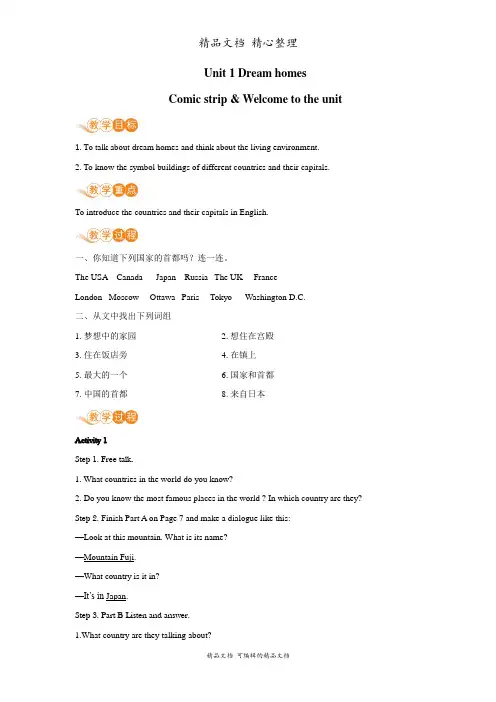
Unit 1 Dream homesComic strip & Welcome to the unit1. To talk about dream homes and think about the living environment.2. To know the symbol buildings of different countries and their capitals.To introduce the countries and their capitals in English.一、你知道下列国家的首都吗?连一连。
The USA Canada Japan Russia The UK FranceLondon Moscow Ottawa Paris Tokyo Washington D.C.二、从文中找出下列词组1. 梦想中的家园___________________2. 想住在宫殿__________________3. 住在饭店旁_____________________4. 在镇上______________________5. 最大的一个_____________________6. 国家和首都__________________7. 中国的首都_____________________8. 来自日本____________________Activity 1Step 1. Free talk.1. What countries in the world do you know?2. Do you know the most famous places in the world ? In which country are they? Step 2. Finish Part A on Page 7 and make a dialogue like this:—Look at this mountain. What is its name?—Mountain Fuji.—What country is it in?—It’s in Japan.Step 3. Part B Listen and answer.1.What country are they talking about?2. Is Mount Fuji near Tokyo?Step 4 Read and act out the dialogue.Activity 2Step 1. Listen to the tape and answer the following questions.1. Where would Eddie like to live?2. Which restaurant does he like best?3. Why would Eddie like to live there?Step 2. Read the dialogue and act it out.Step 3. Fill in the blanksEddie doesn’t w______to live in a p________. He w_______ l_______ to live n_______ t________ a restaurant, because he can have l______ of things to eat. There are many restaurants in Beijing, the _________ of China. H is d________ home is the b________ one.Step 4. Discussion:1. Which country would you like to live in? Why?2. Which city would you like to live in? Why?Read and recite the dialogue.。
沪教牛津版七年级下册初中英语全册教案(教学设计)Unit 1 People around us 教案课题:Unit 1 --- People around us (阅读课)课时:第 1 课时,共4课时课型:new words教学目标:1.To know the meaning of the new words and the students can use the words to make sentences.2.To train the students’ ability o f cooperation.教学重点: The pronunciation and the usages of the new words: cheerful , hard-working , patient, person, smart, forget, smell , strict, encourage, remain , support successful, remember.教学难点: The usages of the new words: forget , remember , patient , strict, remain , strict.教学准备: e some pictures and games and PPT .2.a recorder .教学步骤:Step 1 Warming up. Freely talk:who do you like best around you ?show some pictures of teacher,father ,mother,friend, on the PPT to talk about them.Step 2 New words.1.Read the new words after the teacher or the tape.2.Group work to remember the new words3.Help the students when they have trouble in reading the new wordsStep 3 Key words learning.1.Show the PPT of the meaning of the key words for them to finish Part A1.2. Let Ss make more sentences with the new words .Step 4 Have a competitioncheck the words and give them marks for the groupsstep5 ReadingBefore reading : 1.Ask Ss to look at the pictures and the titles of the three articles on page 3.2.Check their answers.While reading : 1.Read the article quickly, and then finish Part D1.2. Check their answers.Post reading: 1.Ask Ss to finish Part C1 and C2.2. Check their answers.Step 6 Reciting the article1.Play the tape for them to listen and repeat.2.Show PPT for them to retell the article.ExercisesTo consulate the usages of the new wordsstep 7 SummaryGive them a piece of paper to write the words.Step 8 Homework1.Dictation2.correct the mistakesStep9 The blackboard designUnit 1 People around us1. be cheerful快乐2.as well 也3.take care of 照顾4.tell jokes 讲笑话5.make sb laugh 使某人发笑6.be good at 擅长于…7.be strict in sth 对某事严格要求be strict with sb对某人严格要求课题:Unit 1 People around us (听说课)课时:第2课时,共 4 课时课型:Listening & Speaking教学目标:1.Learn how to use the new words or phrases to describe a person2. improve their listening and speaking skills教学重点: To catch the missing words when listening教学难点: Learn to take note quickly when listening教学准备: Group work. Self—study教学步骤:Step 1: Prepare for the listening and speakingReview some words and phrases which can be used to describe a person Step 2: Do the listening1.Play the listening materials , stop when necessary2.Check the answersStep3.SpeakingGive a sample dialogue to students and ask them to imitate itStep 4:Make notes about the listening.1.Tell them to find the key words.2.Write down the key words you get in the listening part.Step5 Speaking1.学习双元音/iə/、/eə/、/uə/1)Read after the teacher or the tape.2)Read by themselves.2.Listen to the tape and finish A1 then check their answers.3.Learn A2. Ask Ss to read these sentences. Pay attention to the letters in red.4.Speaking upWork in groups to discuss the people they like .S1: Who do you like?S2: I like …S1: What does/did he/she look like?…Step6:Sum upStep7HomeworkStep8 The blackboard designUnit 1 People around us1.描写人的外貌的词2. 双元音/iə/、/eə/、/uə/课题:Unit 1 People around us(语法及运用课)课时:第3时,共 4 课时课型:Grammar教学目标:1.to grasp the usage of the definite word the and the preposition with2. to raise the students’ ability to sum up some language rules教学重点: Know when should use the in front of a noun and when we should not use it and the usage of the with phrases to describe a person教学难点: When we should not use the in front of a noun.教学准备:PPT, Blackboard教学步骤:Step1:Free talkTalk about the noun with an, a and the .Step2: WritingBefore writing: Give Ss the title of the article to talk about.1.Who are you going to write about?2.Think about the following ideas.1)a family member2)a good friend3)a teacher or a great personWhile writing:1.Write a short article about this person.Show some PPT to help them to write the article.2.介绍一些描述人常用的词汇.3. Ask Ss to re ad “My dad”as an example.Step3:More practiceAsk Ss to re ad the article about Mother’s Day quickly.Then answer the questions.1.When is Mother’s Day?2.What do people like to do this day?3.What do the author advise people to do on this day?Step4 Study skills1.Learn line graphs and bar charts to show the change in numbers.2.Fill in the blanks.3.Check their answers.Step 4:Culture corner1.Introduce middle names for Ss.2.Write some famous people’s middle names.Step5:Sum up1.Go over the rules of theStep6: HomeworkStep7 The blackboard design1.冠词“a\an”的用法。
人教版初中英语七年级下册教案一、教学目标- 让学生掌握七年级下册英语课本中的基本词汇、短语和句型。
比如说,学生得会用那些日常交流中常用的单词和句子,像打招呼、介绍自己啥的。
嘿,咱还得让学生能流利地朗读课文,语音语调得像那么回事儿。
- 培养学生的英语听说读写综合能力。
听的时候能听懂简单的英语对话和短文;说呢,得大胆开口,表达清楚自己的意思;读要读得顺溜,理解文章大意;写也不能差,能写出简单的英语短文和日记。
- 通过英语学习,拓宽学生的国际视野。
让他们了解不同国家的文化和风俗习惯,增长见识。
二、教学重点与难点- 重点呢,肯定是课本中的重点词汇、句型和语法。
像一般现在时、现在进行时这些语法,学生得掌握好。
还有那些常用的单词和短语,得让他们记得牢,用得对。
- 难点就是学生对英语语法的理解和运用啦。
毕竟语法这东西有点抽象,不好懂。
还有就是口语表达,有些学生可能胆小不敢说,或者说得不流利。
三、教学方法- 咱可以用情境教学法。
比如说,设置一些生活场景,像在超市买东西、在学校里交流啥的,让学生在情境中学习英语,这样更有趣,也更容易记住。
- 游戏教学法也不错。
比如单词接龙、英语猜谜游戏,让学生在玩的过程中学习英语,提高他们的积极性。
- 还可以用多媒体教学法。
放一些英语电影、歌曲啥的,让学生感受英语的魅力。
四、教学过程(一)精彩导入上课铃响了,同学们都陆陆续续回到座位上。
老师微笑着走进教室,神秘地说:“同学们,今天咱们先来听一首好听的英文歌怎么样?”同学们一听,都兴奋起来,纷纷点头说好。
老师打开多媒体设备,播放了一首节奏欢快的英文歌曲《Big Big World》。
歌曲播放完后,老师问同学们:“这首歌好听吗?大家有没有注意到歌里的一些英文单词呀?”同学们七嘴八舌地回答着,有的说听到了“world”,有的说听到了“big”。
老师笑着说:“对呀,今天咱们就来学习一些新的英语单词和语法,就像这首歌里的一样有趣哦。
”(二)趣味知识讲解1. 背景介绍老师拿出一张世界地图,指着地图说:“同学们,我们生活在一个大大的世界里,英语就是我们和世界交流的工具。
Unit 1 Where’s your pen pal from?一、单元教材分析本单元的中心话题是pen pals。
主要语言功能项目是talk about countries, cities and languages。
语法结构为Where…from; Where…live and what language…speak。
先以Activity1复习语言与国家的配对练习入手,Activity2a, 2b一个综合的听力训练来展示学生的听力能力,并以听力内容为基础,通过Activity2c中假设的两人对话操练来培养学生的交流能力,同时也引导学生多沟通与多交流。
Activity3a是一篇email形式的阅读文章,并有相关问题由学生在阅读后进行回答Activity3b 是根据提供的信息进行填空的写作练习,Activity3c 是一篇模仿写作,让学生给自己的笔友写一封关于本人信息的email。
我在各课时教学中设计各种各样的小活动,通过Discussion,Classifying,Guessing等不同方式让学生掌握本单元的知识点,用学会的知识与外国的笔友自如的交谈是学习本单元的目的。
二、教学目标分析1、语言目标a. 重点词汇:Countries: Canada, China, France, Japan, the United States, Singapore, Australia,The United Kingdom, Paris.Cities: Sydney, New York, Toronto, Toyo, LondonLanguages: English, French, Japanese, Chinese.b. 重点句型:-Where…from? -She’s/He’s from…-Where does…live? -She/He lives in …-What language does she /he speak? -She/He speaks ….2、能力目标a. 培养学生在文段中寻找信息的能力;b. 学会用英文给笔友写回信,简单介绍个人情况;c. 通过有效地小组合作,培养学生合作能力及团队精神。
Unit 1 Can you play the guitar?Section A (1a-2d)一、教学目标:1. 语言知识目标:1) 能掌握以下单词:guitar, sing, swim, dance, chess, play chess, draw, speak, speak English, join, club能掌握以下句型:①—Can you play the guitar? —Yes, I can./ No, I can't.②—What can you do? —I can dance.③—What club do you want to join? —I want to join the chess club.2) 能了解以下语法:情态动词can的用法want to do sth.的用法2. 情感态度价值观目标:该部分内容贴近学生的生活,谈论的话题是能力。
通过互相询问或谈论自己或对方在某一方面的能力,可以培养学生的一种群体意识。
二、教学重难点1. 教学重点:1) 学习询问和谈论彼此的能力和特长;2) 掌握一些弹奏乐器的表达方式。
2. 教学难点:情态动词can的构成和使用。
三、教学过程Ⅰ. Lead in1. 教师可携带一些易于演奏的乐器,也可带一些演奏乐器的图片,一边演示乐器,一边说: I can play the guitar.…等;再指着图片说:He/She can play the violin.But I can’t play it.等;然后询问学生:Can you play the guitar?….并引导学生进行简单的回答。
2. S s look at the picture in 1a. Then read the words and phrases. Let Ss match the activities with the people.Then Check the answers with the class together.Ⅱ. Presentation出示一些反映各种活动的图片、幻灯片或播放课件,引导学生谈论活动:He/She can dance/swim/sing/"··But I can’t dance/swim/sing/...等,学习表达活动的动词短语。
最新人教新目标七年级英语下册全英文教案(全册全英文)Unit 1 Can you play the guitar?教学过程♦ Step 4 Role-play1.Ask the students to read the conversation in 2d.try to find: What can Jane/ Bob do?What club do they want to join?2.Ask the students to fill in the forni.(见课件)3.Ask students to practice the conversation according to the for m・4.Ask students to perform the conversation.♦Step 5 Explain several important words and phrases.(见课件)♦Step 6 HomeworkMake a survey about what your friends can do and what club your friends want to join. 板书设计Unit 1 Can you play the guitar教学过程Example:In my group,Li Lin can do kung fii.Liu Kun can tell stories....Fm sure we will give you a good show and make you have a good time・♦ Step 6 HomeworkWrite an ad—Students Wanted for Our Learning Group・板书设计Unit 1 Can you play the guitar4.Ask students to read the passages in 2b.And then match the titles with the ads・5.Check the answers・6.Who fits the job? Match each person in 2a with an ad in 2b.Write A.B and C.(见・课件)7.Check the answers・♦Step 5 Explain important points.♦Step 6 HomeworkWrite a letter to your. teacher.Tell him/lier what you can do for school concert・板书设计课堂练习I •根据汉语意思完成句子1.你能帮我学英语吗?____ you help me ________ English?2.你善于和老人相处吗?____ you ______________ old people?Unit 1 Can you play the guitar(3)hclp⑷be good at/witli/for的用法与区分Work on Self Check 3Ask several students to show their works.♦ Step 5 HomeworkWrite a poster:Artist Wanted for Art Festival.板书设计课堂练习I •单项选择1 ・ Peter __ play soccer・A.can alsoB.also canC.can tooD.too can2.___ you good ______ c hildren?A.Are;forB.Is;in.C.Are;atD.Are;with3.Please call Mr.White ____ 589-267.A.inB.atC.onD.with4.― an you sing or swim?A.YesJ can swimB.NoJ can't swimC.YesJ can singD.I can sing5.___________________________ We want two good actors our school show.Unit 2 What time do you go to school?Keys:(l )From 12:00 at night to 6:00 in the morning. (2)At eight thirty at night. (3) At nine. (4) At ten twenty.(5) At elev亡n o'clock.3.Ask students to practice the conversation in 2d in pairs.教学过程板书设计课堂练习I .根据句意及首字母提示完成单词I・一What t _ da you go to school?—At &00.2.1usually get u ____ at 7:00 every day.What about you?3.__________________________________ My mother bought me two red d on my birthday.4.1need a new b _____ and some new pencils to draw the picture・5.1usually take a s ____ before I go to bed・Keys: 1.time 2.up 3.dresses 4.brush 5.showcrII.用所给词的适当形式填空1. A man has twenty-eight ______ (tooth)・2.Mrs.Li _____ (dress) little Tom every morning.3.My father ______ (work) in a shoe factory.4.Mr.Wang tells us a _____ (fun) story in class.5.1do morning ______ (exercise) with my grandparents every day.Unit 2 What time do you go to school♦Step 2 Learning Grammar Focus1.Ask students to read the sentences in Grammar Focus and translate them into Chinese.,2.Explain several important points・3.Ask students to do some exercises.(见课件)♦Step 3 Writing sentences1 .Work on 3a.Ask the students to write answers or e always,usually or never.2.Ask the students to show the answers.3.Let students write something they always/usually/never do on the blackboard・4.Ask students to do an interview with three students.Find out what time they do the activities in 3c.Then give a report. For example:In our group.Li Fei usually gets up late on weekends.She gets up at...♦Step 4 Explain several important words and phrases.(见课件)♦Step 6 HomeworkWrite an article to mtrodnee your classmate's daily activities.板书设计课堂练习I .根据句意及汉语提示写单词1 .This is a big train (火车)(站)・2.Lily ____ (从不)buys green clothes.3.You don't need to go to school ______ (早地)next Monday.4.The _____ (收音M) player is very nice・5.We have lunch at twelve _______ (点钟).Unit 2 What time do you go to school教学过程♦Step 4 Explain several important points.♦Step 5 HomeworkWrite a passage about your daily life.板书设计课堂练习I .单项选择I.Can you help us do _____ ?A.our homeworksB.our homework homeworks homework2.We go home at half _____ five ______ t he aftemoon.A.to;inB.past;atC.to;atD.past;in3.What time do you eat _____ breakfast? What do you usually have _______ breakfast?A./;/B.for;forC./;forD.for74.1 like to eat __ apples _____ pears.but not grapes・A.either;orB.neither;norC.not only;butD.or;or5.____________ The cake good.I w^nt another one・A.feelsB.tastesC.soundsD.feelsKeys:l—5BDCABII•根据汉语意思完成句子Unit 2 What time do you go to schoolUnit 3 How do you get to school教学过程♦ Step 4 Work on 2dStudent A is Jane and Student B is e the information in 2b to make conversations.A:How do you get to school?B:L・・A:How long does it take...?B:It takes...A:How far is it from...to...?Bit's about...♦Step 5 ReadingAsk students to read the dialogue in 2e and translate it into Chinese.Then ask students to role-play the dialogue. ♦Step 6 HomeworkPractice the conversation in 2c.板书设计课堂练习1.根据句意及汉语提示写单词1 Jim is not happy because he lost his _____ (自行车).2.There are always lots of people on the _____ (公共汽车).3.My aunt takes the ____ (地铁)to work every day.4.—How do you get to Beijing?—I take the ____ (火车).5.1 usually _____ (步行)to school in the morning・Keys: 1.bike 2.bus 3.subway 4.train 5.walkUnit 3 How do you get to school教学过程♦ Step 4 Make a survey 3cl.Show a chart on the screen.(2.Let students ask their classmates questions and write their names in the chart.The firs4 student to fill in all the blanks wins.3.Ask several students to show their results in front of the class・板书设计课堂练习I •单项选择l.____________ How far is from Hangzhou to Wuhan?A.thatB./C.itUnit 3 How do you get to school教学过程4.Check the answers.(见课件)①They go on a ropeway to cross the river to school.②Because they don't have a bridge over die Tiver.③Yes.he does.Because he loves to play with his classmates and he loves his teacher.④The dream is that there .is a bridge over the river.I think their dream can come true.Because all the villagers are working on it.5.Ask the students to read the passage again and complete the sentences in 2c with words from the passage・6.Check the answers・(l)difficult (2)big (3)quickly (4)afraid (5)truc♦ Step 5 HomeworkWrite a short passage about how your classmates go to school.板书设计课堂练习I •根据句意及首字母提示完成单词1.____________ Linda's h is far from her school.2.She t ____ the No.16 bus to school every day.Unit 3 How do you get to school2.F inish Self Check 2.Ask students to write at least five questions with the information in the chart.Then answer thequestions・For example:—How does Tony get to school?—He gets to school by bike・♦ Step 5 HomeworkWrite a passage with t he information in Self Check 2.板书设计课堂练习I•根据汉语意思完成句子1.Mike often _________________ (坐火车)to Beijing.2.Let's go there __________ (乘小汽车).3.My teacher ____________ (像)a friend to me.4.Mrs.Li has _________________ (—个八岁大的)daughter.5.1 eat fruit and vegetables ___________ (每天).6. _ ________ (多长时间)does it take Zhao Lei to do his homework?Keys: 1.takes the train 2.by car 3.is like 4.an eight-year old 5.cvcry day 6.How long II•根据句意,用合适的介词填空1 ・一What do you think _____ the travel?―reat.2.It is about two kilometers ____ my home _______ school.3.Thursday is ____ Wednesday and Friday.4.Jane often goes to school _____ t rain.5.___ many studentsat is easy to get to school. Keys: 1 .of 2.from;to 3.between 4.by 5.For教学反思Unit 4 Don't eat in class.教学过程2.Check the answers.(见课件)(1)It’s not to be late for class.We must be on time.(2)No.they can't.(3)No.they have to wear the school uniform.3.Let students role-play the conversation in 2d in pairs ♦ Step 6 HomeworkWrite the rules in your home.板书设计课堂练习I .根据句意及首字母提示完成单词I.It's very i __ for students to learn English well.2.We must be g _____ in the library.3.We can't eat ill the classroom but we can eat o _____ ・4.Doift a ____ late for class next time.5.Lily w _____ a red dress today.Keys: 1 .important 2.quiet 3.outside 4.arrive 5.wearsII.单项选择1.Don't be late ___ school.A.onB.forC.inD.at2.—Doni eat in the classroom.—__ ,Miss Liu.A.TlianksB.ReallyC.SorryD.Why3.We can't Jisten to music in the classroom. _____ we can do it in the hallways.A.andB.butC.soD.or4.― an I wear hats in class?—__ .but you can wear them after class・A.YesJ canB.Yes.you doC.NoJ can'tD.No,yon cant5.Rose _____ to school very early every day.A.arrivesB.getsC.reachesD.arriveKeys: 1—5 BCBDB教学反思Unit 4 Don,t eat inclass教学课题Section A (Grammar Focus-3c)教学目标【知识目标】Important phrases:wear a hat.wear a uniformImportant sentences:1 Don't run in die hallways.2.—What are the rules?—We must be on time for class・3.― an we eat in the classroom?—No,we can5t,but we can eat in the dinmg hall.4.—Docs he have to wear a uniform at school? ―Yes.he does./ No.he doesn't.5.—What do you have to do?—We have to be quiet in the library.教学重难点【能力目标】1.学会使用祈使句。
Unit 5 Why do you like pandas? 主备课人:叶秋菊 备课人:钟小芳 黄菁 课时安排 Period 1(Section A 1a-1c) Period 2 (Section A 2a-2d) Period 3 (Section A grammar focus-3c) Period 4 (Section B 1a-1d) Period 5 (Section B 2a-2c)
Period 6 (Section B 3a-self-check) Unit 5 Why do you like pandas? Period 1(Section A 1a-1c) 教学目标 ① To observe and describe animals. ② To talk about their preferences
重点 : 学会描述动物的性格及特点。 难点 : 名词的复数形式表示一类事物;第三人称单数形式 教学准备 Tape recorder; Multi-Media; PPT 教学过程 设计 Step One .Lead-in To create an English environment, the teacher shows the class some pictures of a zoo. And ask some questions about animals: Do you like to go to the zoo? Do you like animals? Then have them to recall the animals they had learned and write them on the blackboard as he/she can.( e.g. animals---sheep, monkey, cat, dog, mouse, cow, duck… ) Step Two. Presentation 1. Ask them to talk with their partners about the animals they like using the words they know (Four students a group). —What animals do you like? —Why do you like… —Because they’re… 2. Then show the class some pictures of animals and present other animals. And ask them: What’s this in English? It's a tiger. (Then lion, panda, elephant, koala, giraffe) Ss look at the picture and try to remember the new words of the animals. 3. Next, glue the pictures on the blackboard and ask one student to match the pictures with the words on the cards. Other students turn to page 25 and finish 1a. 4. Check the answers with the class. Step Three.:Game (Guessing game.) T: Show some pictures on the big screen. Let Ss guess what animal it is. Ss try to guess and remember the names of the animals. Step Four: Listening Work on 1b. Tell Ss to listen to the tape and check the animals they hear in 1a. Play the recording again and check the answers with the class. Step Five: Pair work 1. Ask the students to imagine “ We are in the zoo, there are many kinds of animals here.” Then ask a student to do the model with you: — Let’s see the lions first. —Why? (why do you /does she /does he like lions?) —Because they are interesting. 2. Ss work with their partners practice the conversation using the animal in 1a. Step Six. Homework 1. Remember the new words and expressions.
教学反思:
Unit 5 Why do you like pandas? Period 2 (Section A 2a-2d) 教学目标 To know the implied meaning of some animals. 重点 学会表达喜欢某类动物及说明喜欢的原因。 难点 名词的复数形式表示一类事物;第三人称单数形式。 教学准备 Tape recorder; Multi-Media; PPT 教学过程 设计 Step One .Lead-in 1. Greet the Ss as usual. 2. Check the homework Step Two. Listening 1. Work on 2a; T: Listen to the conversation carefully. Then write the names of the animals you hear on these lines.Play the recording the first time. Students only listen.Play the recording a second time. This time students write in the names of the animals. Check the answers. Point out the adjectives and countries listed on the right. Ask a student to say the words. Say, Now I will play the recording again. This time draw a line between each animal and the adjective and countries you hear. Play the recording and have students match each animal with an adjective and a country. Correct the answers. 2. Work on 2b T: Listen again and complete the conversation with the words in 2a. Play the recording for the Ss to listen and write the answers. Check the answers with the class. 3. Check the answers: Step Three. Pair work 1. Ask two students to read the conversation in 2b to the class. 2. Ss practice the conversation in pairs. 3. Then show the transcription on the big screen and practice the other two conversations in 2a. 4. Ss practice the conversations in pairs. Step Four: Role-play 1. Ask Ss to look at the picture in 2d. Then Ss read the conversation in 2d and find the answers to the questions: ① Does Peter have a pet? ② What can Dingding do? ③ What pet does Jenny’s mom have? ④ Does Jenny like the cat? Why? 2. Ss read the conversations and try to find the answers to the questions. Check the answers: Yes, he does. He can walk on two legs. He can dance, too. She has a cat. No, she doesn’t. Because it’s very lazy. 3. Ss work in pairs and practice the conversation. 4. Let some pairs role-play the conversation. Step Five.Homework 1.Role-play the conversation after class. 2. Write the animal's names as many as possible in the exercises book.
教学反思:
Unit 5 Why do you like pandas? Period 3 (Section A grammar focus-3c)